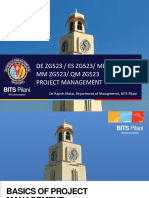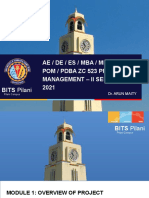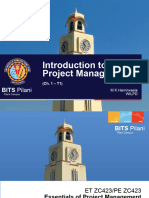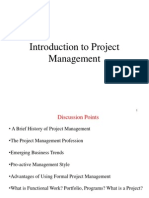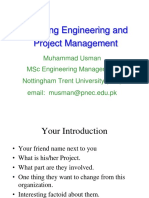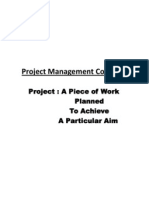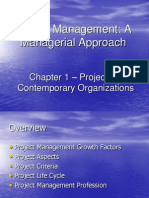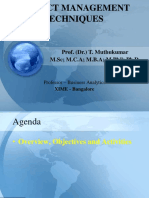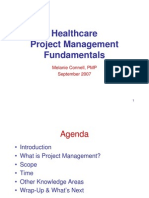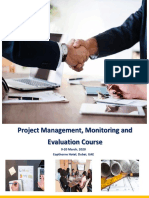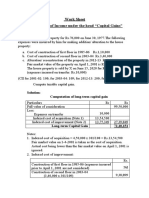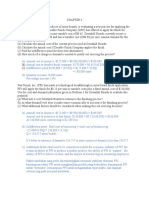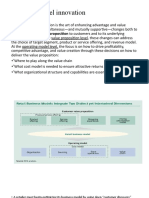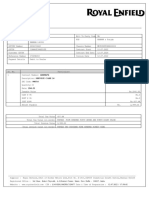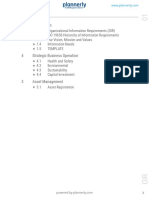Et Zc423 / Pe Zc423 / Powtp ZC423: BITS Pilani BITS Pilani
Et Zc423 / Pe Zc423 / Powtp ZC423: BITS Pilani BITS Pilani
Uploaded by
SHRIDHARA N NagarajCopyright:
Available Formats
Et Zc423 / Pe Zc423 / Powtp ZC423: BITS Pilani BITS Pilani
Et Zc423 / Pe Zc423 / Powtp ZC423: BITS Pilani BITS Pilani
Uploaded by
SHRIDHARA N NagarajOriginal Description:
Original Title
Copyright
Available Formats
Share this document
Did you find this document useful?
Is this content inappropriate?
Copyright:
Available Formats
Et Zc423 / Pe Zc423 / Powtp ZC423: BITS Pilani BITS Pilani
Et Zc423 / Pe Zc423 / Powtp ZC423: BITS Pilani BITS Pilani
Uploaded by
SHRIDHARA N NagarajCopyright:
Available Formats
ET ZC423 / PE ZC423 / POWTP
ZC423
ESSENTIALS OF PROJECT
MANAGEMENT
BITS Pilani FIRST SEMESTER 2019-20
Pilani Campus M K Hamirwasia
BITS Pilani
Pilani Campus
MODULE 1: BASICS OF PROJECT
MANAGEMENT
Lecture No. 1
Introduction to Project
Management
• Definition of Project Management
• Evolution of Project Management
• Definition of a Project
• Characteristics of a Project
• The Project Life Cycle
• Project, Program, Portfolio
• Current Drivers of Project Management
• The Project Manager
• Project Management Process Groups
• Project Management Knowledge Areas
• Project Integration Management
• Some Definitions
BITS Pilani, Pilani Campus
Characteristics of a Project
• A Project consists of a series of activities and tasks that
– Have a Specific Objective to be Completed within
Certain Specifications
– Have Definite Start and End Dates
– Have Funding Limits
– Consume Resources (human and non-human)
– Meet and Exceed Customer Needs
– Are Multifunctional - the Involvement of Several
Departments and Professionals
– Typically Involve Doing Something That has Never been
Done Before.
BITS Pilani, Pilani Campus
Current Drivers of PM
• Time to Market
• Complexity (Tech.)
• Sustainable Development
• Corp. Downsizing (Outsourcing)
• Fulfil Customer Needs (Customization…)
• Project Portfolio Management
BITS Pilani, Pilani Campus
Some Definitions
• Scope
• Scope Creep
• Plan
• Task
• Resource
• Assignment
BITS Pilani, Pilani Campus
INTRODUCTION TO
PROJECT MANAGEMENT
• Evolution and Application
• Project
• Project, Program, Portfolio
• Project Life Cycle
• The Project Manager
• Being Part of a Project Team
• Project Integration Management
BITS Pilani, Pilani Campus
EVOLUTION and
APPLICATION
• Developed in the late 1950’s to aid planning and scheduling of
large projects
• Defence
• Construction Industry
• Aerospace
• Automakers – Toyota, Nissan, BMW
• Electronics
• Information Technology
• Steel & Cement
• Fertilizer
• Oil and Gas
• Pharmaceutical
BITS Pilani, Pilani Campus
WHAT IS A PROJECT?
• A Project is a Complex, Non-routine, One-time Effort Limited
by Time, Resources and Performance Specifications Designed
to Meet Customer Needs.
• A Project is a Temporary Endeavour to Create a Unique
Product, Service or Result.
• EXAMPLES
• Introduction of a new kind of detergent in the market
• Enhancing the capacity of a plant
• Reducing the downtime of machines
• Improving the Quality of a Product
• Erection and Commissioning of a Power Plant
• Preparation of documents for takeover of a Firm
• Overhauling and Turnaround of an Oil Refinery
BITS Pilani, Pilani Campus
CHARACTERISTICS,
ELEMENTS AND NEEDS
• CHARACTERISTICS
• A Project consists of a series of activities and tasks that
– Have a Specific Objective to be Completed within Certain
Specifications
– Have Definite Start and End Dates
– Have Funding Limits
– Consume Resources (human and non-human)
– Meet and Exceed Customer Needs
– Are Multifunctional - the Involvement of Several Departments
and Professionals
– Typically Involve Doing Something That has Never been Done
Before.
BITS Pilani, Pilani Campus
ELEMENTS OF A PROJECT
• Project Selection
• Prioritization Of Projects
• Scope Of Work
• Work Breakdown Structure
• Risk Management
• Cost and Time Estimate
• Procurement
• Allocation Of Resources
• Execution Of Jobs
BITS Pilani, Pilani Campus
ELEMENTS OF A PROJECT
• Subcontracting
• Regular Review
• Feedback
• Control
• Commissioning
• Final Handing Over to the Client
• Evaluation of Project Manager and Team
• Retrospectives
BITS Pilani, Pilani Campus
NEED OF A PROJECT
Project: Fulfilling the needs and requirements of the
Customer
Stakeholders: Meeting the needs of Stakeholders
Organization: Meeting the strategic needs of the
organization
Individuals: Meeting the goals and aspirations of Project
Manager and project team members
BITS Pilani, Pilani Campus
PROJECT DRIVEN ORGANIZATION Vs NON-
PROJECT DRIVEN ORGANIZATION
• Project Management in project-driven organizations is
mature and respected. On the other hand, in non-project-
driven organizations, Project Management is still in its
infancy, and is often looked at with skepticism.
• Project-driven organizations make the lion’s share of their
income through projects; non-project-driven organizations
mainly make their income through production.
• The Project Manager is responsible of the profitability and
loss in project-driven organizations. In non-project-driven
organizations, the responsibility for profitability and loss is
ambiguous.
BITS Pilani, Pilani Campus
PROJECT DRIVEN ORGANIZATION Vs NON-
PROJECT DRIVEN ORGANIZATION
• Project-driven organizations adopt either fully projectized
or matrix organizational structures. Non-project-driven
organizations usually adopt a
functional organizational structure.
• Project-driven organizations have flexible career paths,
where one can ascend quickly to higher positions. Non-
project-driven organizations have traditional career
paths, where moving upwards in the company ladder is
very difficult. Quite often, one has to wait for their
manager to get fired/resign/retire/perish to ascend the
company’s ladder and assume a better position.
BITS Pilani, Pilani Campus
PROJECT DRIVEN ORGANIZATION Vs NON-
PROJECT DRIVEN ORGANIZATION
Examples of industries where project-driven organizations are
predominant include:
• Construction
• Aerospace
• Research
Examples of industries where non-project-driven organizations are
predominant include:
• Manufacturing
• Services
• Farming
• Natural Resources
BITS Pilani, Pilani Campus
PROJECT DRIVEN ORGANIZATION Vs NON-
PROJECT DRIVEN ORGANIZATION
IT (Information Technology) organizations (that fall under
the services industry) are considered to be hybrid, where
parts of such organizations are considered to be project-
driven (such as the development of a new software),
while other parts are considered to be non-project-driven
(for example supporting applications).
BITS Pilani, Pilani Campus
LIMITATIONS OF NON-PROJECT
DRIVEN ORGANIZATIONS
• Projects may be few and far between
• Not all Projects have the same Project Management
Requirements
• Executives do not have Sufficient Time to Manage
Projects
• Projects Tend to be Delayed Because Approvals most
often Follow Vertical Chain of Command
• Project Staffing is on a Local Basis
• Heavy Dependence upon Subcontractors and Outside
Agencies for Project Management Expertise
BITS Pilani, Pilani Campus
TYPES OF PROJECTS
• Classification of Projects
• Different Sectors: Public Sector, Private Sector, Service
Sector, Joint Sector
• Industrial
• Software
• Service
• Infrastructure
• Construction
• Expansion
• Modernization
BITS Pilani, Pilani Campus
Types of Projects
• Maintenance
• Plant Shutdown and Turnaround
• Diversification
• Integration
• Forward Integration
• Backward Integration
• Vertical Integration
• Acquisition
• Rehabilitation
• Research and Development
BITS Pilani, Pilani Campus
WHY DO PROJECTS FAIL?
• Inadequately trained and /or inexperienced project
managers
• Failure to set and manage expectations
• Poor leadership at any and all levels
• Failure to adequately identify , document and track
requirements
• Poor plans and planning processes
• Poor effort estimation
• Cultural and ethical misalignment
BITS Pilani, Pilani Campus
Top 10 Reasons Projects
Fail
• Misalignment between the project team and the business
or other organizations it serves
• Inadequate or misused methods
• Inadequate communication , including progress tracking
and reporting
BITS Pilani, Pilani Campus
PROJECT LIFE CYCLE
• Project Life Cycle recognizes that projects have limited
span
• Predictable changes in level of effort and focus over the
life of the project
• Stages:
• Defining Stage
• Planning Stage
• Executing Stage
• Delivery / Closing Stage
BITS Pilani, Pilani Campus
Project Life Cycle
DEFINING
Goals
Specifications
Task
Responsibilities
PLANNING
Scheduling
Budgets
Resources
Risks
Staffing
BITS Pilani, Pilani Campus
Project Life Cycle
EXECUTING
Status Reports
Changes
Quality
Forecasts
CLOSING / DELIVERY
Train Customer
Transfer Documents
Release Resources
Evaluation
Lessons Learned
BITS Pilani, Pilani Campus
PRODUCT LIFE CYCLE
• Research and Development
• Market Introduction
• Growth
• Maturity
• Deterioration
• Death
BITS Pilani, Pilani Campus
LIFE CYCLE PHASES FOR
DIFFERENT PROJECTS
• Engineering
– Start Up
– Definition
– Main
– Termination
• Manufacturing
– Formation
– Building
– Production
– Phase-out
– Final Audit
BITS Pilani, Pilani Campus
LIFE CYCLE PHASES FOR
DIFFERENT PROJECTS
• Software Development
– Conceptual
– Planning
– Definition and Design
– Code
– Integration / Testing
– Conversion
– Maintenance
• Construction
– Planning, Data Collection and Procedures
– Studies and Basic Engineering
– Major Review
– Detailed Engineering
– Construction
– Testing and Commissioning
BITS Pilani, Pilani Campus
The Project Manager
A project manager is a person who has the overall responsibility for
the successful initiation, planning, design, execution, monitoring,
controlling and closure of a project. Construction, petrochemical,
architecture, information technology and many different
industries that produce products and services use this job title.
The project manager must have a combination of skills including
an ability to ask penetrating questions, detect unstated
assumptions and resolve conflicts, as well as more general
management skills.
Key among a project manager's duties is the recognition that risk
directly impacts the likelihood of success and that this risk must
be both formally and informally measured throughout the lifetime
of a project.
BITS Pilani, Pilani Campus
The Project Manager
Risks arise from uncertainty, and the successful project
manager is the one who focuses on this as their primary
concern. Most of the issues that impact a project result in
one way or another from risk. A good project manager can
lessen risk significantly, often by adhering to a policy of
open communication, ensuring every significant participant
has an opportunity to express opinions and concerns.
A project manager is a person who is responsible for making
decisions, both large and small. The project manager
should make sure they control risk and minimize
uncertainty. Every decision the project manager makes
must directly benefit their project.
BITS Pilani, Pilani Campus
The Project Manager
Roles and Responsibilities
The role of the project manager encompasses many activities
including:
Planning and Defining Scope
Activity Planning and Sequencing
Resource Planning
Developing Schedules
Time Estimating
Cost Estimating
Developing a Budget
Documentation
Creating Charts and Schedules
BITS Pilani, Pilani Campus
The Project Manager
Risk Analysis
Managing Risks and Issues
Monitoring and Reporting Progress
Team Leadership
Strategic Influencing
Business Partnering
Working with Vendors
Scalability, Interoperability and Portability Analysis
Controlling Quality
Benefits Realization
Finally, senior management must give a project manager support and authority if
he or she is going to be successful.
BITS Pilani, Pilani Campus
Being Part of a Project
Team
Team members are selected because they have particular
skills that are required to complete project tasks. Examples
include specialists in business or technical disciplines, or
an outside supplier.
The Team Member’s role is to successfully perform the tasks
that have been allocated, keeping the project manager
informed of progress as well as any issues that may arise.
The role often requires team members to work on their own
initiative in areas where they are the ‘experts’. This places
the responsibility on them to manage their own day to day
work, recognize the authority of the Project Manager and
report to the Project Manager as appropriate.
BITS Pilani, Pilani Campus
Being Part of a Project
Team
Team membership often changes as a project moves through
its development. This means there are frequently two types
of team member:
Core Team Member - a full time role on the project but not
necessarily for the duration of the project.
Extended Team Member - a part time role on the project .
These team members will usually have their regular job to
do, or they may be from an outside company.
Part of the Team Member’s role is to pay attention to the
problems others may be facing. Tolerance and good
communications are essential ingredients of successful
project teams.
BITS Pilani, Pilani Campus
Being Part of a Project
Team
The responsibilities assigned to individual team members
may vary but typically will include:
• understanding the purpose and objectives of the project
• ensuring a correct balance between project and non-
project work
• working to timescales and within cost constraints
• reporting progress against plan
• producing the deliverables/products to agreed
specifications
• reviewing key project deliverables/products
BITS Pilani, Pilani Campus
Being Part of a Project
Team
• identifying issues
• identifying risks associated with the project
• working together as a team
• contributing towards successful communication
• contributing towards positive motivation
On small or specialized projects, the Team Member may
also be the Project Manager.
BITS Pilani, Pilani Campus
PROJECT INTEGRATION
MANAGEMENT
Inputs Outputs
(Resources) Integrated Process (Products, Services, Profits)
BITS Pilani, Pilani Campus
PIM
Project Integration Management is a collection of
processes required to ensure that the various elements
of the projects are properly coordinated. It involves
making trade-offs among competing objectives and
alternatives to meet or exceed stakeholder needs and
expectations.
In other words, Project Integration Management process
comprises of activities like identifying, defining,
combining, and coordinating various processes related
to project.
BITS Pilani, Pilani Campus
ET ZC423 / PE ZC423 /
POWTP ZC423 – L1
Thank You!
Sampark Sutra:
M K Hamirwasia
+91 85868 14104
hamirwasiamk@pilani.bits-pilani.ac.in
BITS Pilani, Pilani Campus
You might also like
- McNeill Et Al-2015-International Journal of Consumer StudiesDocument11 pagesMcNeill Et Al-2015-International Journal of Consumer Studiesrajat gargNo ratings yet
- Circular Flow LessonDocument13 pagesCircular Flow LessonKimball SarmientoNo ratings yet
- S2-18-De Zg523es Zg523mba Zg523mm Zg523pom Zg523qm Zg523 - l1Document37 pagesS2-18-De Zg523es Zg523mba Zg523mm Zg523pom Zg523qm Zg523 - l1Pvss PrasadNo ratings yet
- 2021 - PJM - L - 1 - 1627131557715-Project ManagementDocument58 pages2021 - PJM - L - 1 - 1627131557715-Project ManagementKumar AbhishekNo ratings yet
- Ae / de / Es / Mba / MM / QM / Pom / Pdba ZC 523 Project Management - Ii Sem 2020 - 2021Document78 pagesAe / de / Es / Mba / MM / QM / Pom / Pdba ZC 523 Project Management - Ii Sem 2020 - 2021VINU V CHALAMNo ratings yet
- Project Audit Closure and OutsourcingDocument65 pagesProject Audit Closure and OutsourcingajithNo ratings yet
- L1-Intro To PMDocument50 pagesL1-Intro To PMRanjith RaoNo ratings yet
- L2-Modern Project MGMTDocument54 pagesL2-Modern Project MGMTRanjith RaoNo ratings yet
- 2021 - PJM - L - 2 - 1627735738763-Project ManagementDocument67 pages2021 - PJM - L - 2 - 1627735738763-Project ManagementKumar AbhishekNo ratings yet
- 2023 Mba PJM L 3Document75 pages2023 Mba PJM L 3Amit SinghNo ratings yet
- L11-Organization Structure & CultureDocument41 pagesL11-Organization Structure & Culturesiranjivikumar.m1No ratings yet
- Project Management Lect-3Document42 pagesProject Management Lect-3siranjivikumar.m1No ratings yet
- Bab 1 The Nature of Information Technology ProjectsDocument22 pagesBab 1 The Nature of Information Technology ProjectsClara PanggabeanNo ratings yet
- Introduction To PMDocument35 pagesIntroduction To PMprashantpardheNo ratings yet
- PROJECT MANAGEMENT DAY 1.keyDocument109 pagesPROJECT MANAGEMENT DAY 1.keyRanga Chris ChimombeNo ratings yet
- Lecture 1 Introduction To Project Management 09-10-2007Document44 pagesLecture 1 Introduction To Project Management 09-10-2007Bilal Hussain ShahNo ratings yet
- Project Management: Casmir, R. (PH.D)Document23 pagesProject Management: Casmir, R. (PH.D)Rodric PeterNo ratings yet
- Chapter 15 Managing Engineering and TechnologyDocument20 pagesChapter 15 Managing Engineering and TechnologyAli HassanNo ratings yet
- Project Management FrameworkDocument47 pagesProject Management FrameworkNamig Pashayev100% (1)
- Project Evaluation and Implementation: Course Code: 401Document31 pagesProject Evaluation and Implementation: Course Code: 401Sajal SinghalNo ratings yet
- Project AppraisalDocument35 pagesProject AppraisalVinoth Kumar100% (1)
- ProjectWay Company ProfileDocument18 pagesProjectWay Company ProfileNeha MishraaNo ratings yet
- PMP MaterialDocument221 pagesPMP MaterialMd AlanaziNo ratings yet
- OverviewDocument51 pagesOverviewThu Hoài NguyễnNo ratings yet
- 7.project ManagementDocument25 pages7.project Managementm jahangirNo ratings yet
- Module 4 - Establishing An Enterprise and Project ManagementDocument40 pagesModule 4 - Establishing An Enterprise and Project ManagementApoorv GoelNo ratings yet
- Project Management Concepts: Project: A Piece of Work Planned To Achieve A Particular AimDocument33 pagesProject Management Concepts: Project: A Piece of Work Planned To Achieve A Particular AimAyushi RawalNo ratings yet
- Project Initiation After Business CaseDocument51 pagesProject Initiation After Business Casemaddy.mahad2005No ratings yet
- Project Management Presentation FRAMEWORK - NewDocument131 pagesProject Management Presentation FRAMEWORK - NewAsare AmoabengNo ratings yet
- Lecture One Intro To PM 2609Document45 pagesLecture One Intro To PM 2609Orhan BagashovNo ratings yet
- Topic 1 Introduction To Project ManagementDocument25 pagesTopic 1 Introduction To Project ManagementEL- Musa100% (1)
- I Need No BopdyDocument7 pagesI Need No Bopdyajaykumar_domsNo ratings yet
- Sahil PMDocument14 pagesSahil PMrohin gargNo ratings yet
- Chapter 1 Project IntroductionDocument16 pagesChapter 1 Project Introductionmddev87No ratings yet
- Project Management: A Managerial Approach: - Projects in Contemporary OrganizationsDocument26 pagesProject Management: A Managerial Approach: - Projects in Contemporary OrganizationsDjy DuhamyNo ratings yet
- Project Management ConceptsDocument35 pagesProject Management ConceptsNurfitry HareqhNo ratings yet
- PM Module 1Document53 pagesPM Module 1yashantsh4No ratings yet
- Project Management - I Sem 2021-2022: BITS Pilani BITS PilaniDocument47 pagesProject Management - I Sem 2021-2022: BITS Pilani BITS PilaniKumar AbhishekNo ratings yet
- Final Lecture Note On Advanced Project Analysis and ManagementDocument313 pagesFinal Lecture Note On Advanced Project Analysis and Managementmustefa ademNo ratings yet
- BAB906 Project Management Fundamentals WK 2 Instructor VersionDocument45 pagesBAB906 Project Management Fundamentals WK 2 Instructor VersionAbdul AleemNo ratings yet
- Introduction To Project ManagementDocument20 pagesIntroduction To Project ManagementlyleholstNo ratings yet
- D0804001022013402802 - Project Life Cycle - D0804Document14 pagesD0804001022013402802 - Project Life Cycle - D0804Siska0806No ratings yet
- BUS1040 Lecture Week 1Document24 pagesBUS1040 Lecture Week 1Farhad ShiriNo ratings yet
- Project Management Professional (Training)Document182 pagesProject Management Professional (Training)Realzoey100% (1)
- Project Management Techniques: Prof. (DR.) T. Muthukumar M.SC M.C.A M.B.A M.Phil PH.DDocument65 pagesProject Management Techniques: Prof. (DR.) T. Muthukumar M.SC M.C.A M.B.A M.Phil PH.DDinesh KumarNo ratings yet
- Project AuditingDocument6 pagesProject Auditingipm21040No ratings yet
- 1-Project ManagementDocument100 pages1-Project ManagementRaunak YadavNo ratings yet
- CAPM Notes 2022Document55 pagesCAPM Notes 2022Haslina HashimNo ratings yet
- Healthcare PM Fundamentals Sept 2007 ScribdDocument78 pagesHealthcare PM Fundamentals Sept 2007 Scribdmelanie928No ratings yet
- Project Identification /implementation/ ManagementDocument70 pagesProject Identification /implementation/ ManagementOmar B. RomaNo ratings yet
- Project Management PPT WordDocument111 pagesProject Management PPT Wordeldanasime9No ratings yet
- Project Management PrinciplesDocument93 pagesProject Management PrinciplesDavid MoliaNo ratings yet
- Chapter 1 PM (A)Document30 pagesChapter 1 PM (A)sing blingNo ratings yet
- 2 - Project Management FoundationDocument41 pages2 - Project Management FoundationKimo KenoNo ratings yet
- CENG 6101 Project Management: Wubishet Jekale Mengesha (Dr. Eng.) July, 2014Document73 pagesCENG 6101 Project Management: Wubishet Jekale Mengesha (Dr. Eng.) July, 2014Abera Mamo JaletaNo ratings yet
- D3 - Six Sigma ProjectsDocument35 pagesD3 - Six Sigma ProjectsAzer Asociados SacNo ratings yet
- Introduction To Project ManagementDocument38 pagesIntroduction To Project ManagementOlatunji Emmanuel KofiNo ratings yet
- Project Management Course ObjectivesDocument23 pagesProject Management Course Objectivesajaykumar_domsNo ratings yet
- 2020-03 Course Outline - Project MGT, M & eDocument7 pages2020-03 Course Outline - Project MGT, M & eprofessionNo ratings yet
- OP158 PowerPoint Presentation LCDocument31 pagesOP158 PowerPoint Presentation LCDonald SimonNo ratings yet
- Capital Budgeting - THEORYDocument9 pagesCapital Budgeting - THEORYAarti PandeyNo ratings yet
- TheEdge + Sun-240124Document52 pagesTheEdge + Sun-240124one2paii-1No ratings yet
- INCOTERMS 2020 - Matriz de ResponsabilidadesDocument8 pagesINCOTERMS 2020 - Matriz de ResponsabilidadesMaycon Porras AguilarNo ratings yet
- Jhon Alvarez ENGDocument2 pagesJhon Alvarez ENGJhon AlvarezNo ratings yet
- 1 1 MFI Survey QuestionnaireDocument26 pages1 1 MFI Survey QuestionnaireAbhishek Singh75% (4)
- Fa I HoecDocument32 pagesFa I HoecBunny SethiNo ratings yet
- 3 The Global Economy1Document36 pages3 The Global Economy1Aldrien CatipayNo ratings yet
- Liquidation of A CompanyDocument51 pagesLiquidation of A Companyeshu agNo ratings yet
- ProjectDocument20 pagesProjectSUBHASMITA SAHUNo ratings yet
- Work Sheet Computation of Income Under The Head "Capital Gains"Document4 pagesWork Sheet Computation of Income Under The Head "Capital Gains"Vishal SarkarNo ratings yet
- DMart Case Study - Group 06Document3 pagesDMart Case Study - Group 06Siddhi GodeNo ratings yet
- Group9 Brazil Macroecoomics PDFDocument12 pagesGroup9 Brazil Macroecoomics PDFANJULI AGARWALNo ratings yet
- Rek Koran PT HAI Mandiri 2022Document115 pagesRek Koran PT HAI Mandiri 2022wahyu suhartono100% (1)
- Ahmad FA - Chapter4Document1 pageAhmad FA - Chapter4ahmadfaNo ratings yet
- Session 7 Retail Liability ProductsDocument19 pagesSession 7 Retail Liability ProductsLagishetty AbhiramNo ratings yet
- Regeneration DocklandsDocument44 pagesRegeneration DocklandsYoselin RojasNo ratings yet
- Fact SheetDocument5 pagesFact Sheetapi-288962582No ratings yet
- Re Care PackageDocument1 pageRe Care PackageYuvraj BanwaitNo ratings yet
- OIR Jul-19-2021Document8 pagesOIR Jul-19-2021leomanzioneNo ratings yet
- Evaluating A Firms Financial Performance by Keown3Document36 pagesEvaluating A Firms Financial Performance by Keown3talupurum100% (1)
- MCQ ModelDocument11 pagesMCQ ModelRahul RavindranathanNo ratings yet
- Colgate 1Document23 pagesColgate 1hybrid_chordNo ratings yet
- Going Global - Acting Local Marketing Strategy ofDocument8 pagesGoing Global - Acting Local Marketing Strategy ofPraneit KhotNo ratings yet
- Adv ICo Stock Transfer Restrictions 2022 OPDocument8 pagesAdv ICo Stock Transfer Restrictions 2022 OPKiran JadhavNo ratings yet
- Admission of A Partner, Class 12, CbseDocument13 pagesAdmission of A Partner, Class 12, CbseTULIP DAHIYANo ratings yet
- Meaning of Elasciticity of DemandDocument9 pagesMeaning of Elasciticity of DemandDonasco Casinoo ChrisNo ratings yet
- GMGA3037 3rd HandoutDocument27 pagesGMGA3037 3rd HandoutBibi Shafiqah Akbar ShahNo ratings yet
- Form PDF 654140500171020Document61 pagesForm PDF 654140500171020Sameer Shekhar ShuklaNo ratings yet


